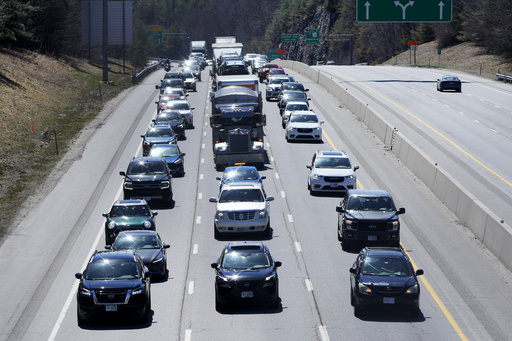FRANCONIA, N.H. (AP) — Thousands of visitors to northern New England communities in the path of the total solar eclipse were told to pack their patience for the trip. In some areas, they needed it for up to 12 hours after the event started, inching their way back home on packed interstates and secondary roads.
In New Hampshire, travelers were stuck in bumper-to-bumper traffic in the northern part of the state through at least 2 a.m. Tuesday, clogging up southbound Interstate 93. Southbound traffic on Interstate 89 also was heavy Monday evening. Southbound traffic was backed up in parts of Maine for several hours.
New England had clear skies and mild weather Monday, making for ideal viewing conditions for totality. In New Hampshire, people flocked to places such as Lancaster, Stewartstown, Colebrook and Pittsburg, near the Canada border.
But the roads were swarmed on the trip back, and traffic came to a standstill in some areas.
“People were just pulling over on the side of the road going to the bathroom, people were pulling over to shut their cars off, sleeping in their cars all over (U.S.) Route 3,” said Scott Lacourse, who left his vacation home in Pittsburg with his wife and their two dogs at 6:30 p.m. They got home to Londonderry, New Hampshire, nine hours later. That’s nearly three times longer than usual.
“Every rest area, any pull-off, anything, was full,” Lacourse said, adding that there also was no cell service.
Some people who had paper maps with them navigated their way through back roads. Others were running out of gas, and some broke down. Some people opted for the dangerous maneuver of driving across a median ditch and turning back onto northbound lanes. At least one car got stuck in the ditch. Some people who tried to stop for fast food along the way were met by a long line and the realization that the staff had stopped taking orders.
Lacourse and his wife, Sirena Holobinko Bogdahn, thought that if they left later in the day traffic would be cleared, but that wasn’t the case.
In spite of that, “it was well worth it,” she said of the eclipse viewing. “It was so amazing.”
John Martin, who was visiting from Massachusetts, described it as a “creep and a crawl” near Franconia, where Route 3 feeds into the Franconia Notch Parkway, a one-lane mountain pass in each direction, before expanding into the multilane interstate.
“You’re looking at your GPS trying to get off of 93 to find something a little quicker, and everybody else was thinking the same thing,” he told WMUR-TV.
New Hampshire state officials had warned travelers that the return could be slow going and encouraged people to stay in the area, which usually sees its most tourists during the summer and the fall foliage season, for a while.
“To our friends visiting from out of state, remember: there’s no sales tax in NH, so feel free to stay a bit longer!” Gov. Chris Sununu had said Friday.
Traffic also slowed to a crawl in other states.
In Maine, the traffic on Route 4 south from Rangeley to Farmington was heavy and slow several hours after the eclipse but never completely stopped, averaging 8 to 15 mph for much of the 40-mile drive along the two-lane rural road that threads mountains and hills.
In Paducah, Kentucky, which was in the path of totality, along with communities to the west in Illinois, thousands of people crossed the Ohio River after watching the eclipse. Post-eclipse traffic also moved very slowly in places such as southbound Interstate 65 in southern Indiana, and along southbound Interstate 81 in New York and Pennsylvania.
___
McCormack reported from Concord, New Hampshire. Associated Press journalist Robert Bukaty in Portland, Maine, contributed to this report.
This website uses cookies so that we can provide you with the best user experience possible. Cookie information is stored in your browser and performs functions such as recognising you when you return to our website and helping our team to understand which sections of the website you find most interesting and useful.
